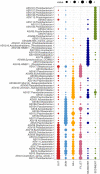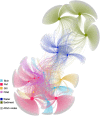Host-associated and Environmental Microbiomes in an Open-Sea Mediterranean Gilthead Sea Bream Fish Farm
- PMID: 36205738
- PMCID: PMC10335962
- DOI: 10.1007/s00248-022-02120-7
Host-associated and Environmental Microbiomes in an Open-Sea Mediterranean Gilthead Sea Bream Fish Farm
Abstract
Gilthead seabream is among the most important farmed fish species in the Mediterranean Sea. Several approaches are currently applied to assure a lower impact of diseases and higher productivity, including the exploration of the fish microbiome and its manipulation as a sustainable alternative to improve aquaculture practices. Here, using 16S rRNA gene high-throughput sequencing, we explored the microbiome of farmed seabream to assess similarities and differences among microbial assemblages associated to different tissues and compare them with those in the surrounding environment. Seabream had distinct associated microbiomes according to the tissue and compared to the marine environment. The gut hosted the most diverse microbiome; different sets of dominant ASVs characterized the environmental and fish samples. The similarity between fish and environmental microbiomes was higher in seawater than sediment (up to 7.8 times), and the highest similarity (3.9%) was observed between gill and seawater, suggesting that gills are more closely interacting with the environment. We finally analyzed the potential connections occurring among microbiomes. These connections were relatively low among the host's tissues and, in particular, between the gut and the others fish-related microbiomes; other tissues, including skin and gills, were found to be the most connected microbiomes. Our results suggest that, in mariculture, seabream microbiomes reflect only partially those in their surrounding environment and that the host is the primary driver shaping the seabream microbiome. These data provide a step forward to understand the role of the microbiome in farmed fish and farming environments, useful to enhance disease control, fish health, and environmental sustainability.
Keywords: Aquaculture sustainability; Fish microbiome; Gilthead seabream; Mediterranean Sea.
© 2022. The Author(s).
Conflict of interest statement
The authors declare no competing interests.
Figures



References
-
- FAO . The state of world fisheries and aquaculture 2020. Rome: Sustainability in action; 2020.
-
- Ape F, Manini E, Quero GM, Luna GM, Sara G, Vecchio P, Brignoli P, Ansferri S, Mirto S. Biostimulation of in situ microbial degradation processes in organically-enriched sediments mitigates the impact of aquaculture. Chemosphere. 2019;226:715–725. doi: 10.1016/j.chemosphere.2019.03.178. - DOI - PubMed
-
- Rosado D, Perez-Losada M, Severino R, Cable J, Xavier R. Characterization of the skin and gill microbiomes of the farmed seabass (Dicentrarchus labrax) and seabream (Sparus aurata) Aquaculture. 2019;500:57–64. doi: 10.1016/j.aquaculture.2018.09.063. - DOI
-
- Neofitou N, Vafidis D, Klaoudatos S. Spatial and temporal effects of fish farming on benthic community structure in a semi-enclosed gulf of the Eastern Mediterranean. Aquac Environ Interact. 2010;1:95–105. doi: 10.3354/aei00010. - DOI
-
- Rosa R, Marques A, Nunes ML. Impact of climate change in Mediterranean aquaculture. Rev Aquac. 2012;4:163–177. doi: 10.1111/j.1753-5131.2012.01071.x. - DOI
MeSH terms
Substances
LinkOut - more resources
Full Text Sources

